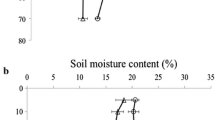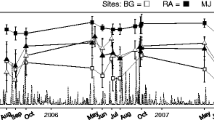Abstract
Biologically driven markers or monitors were used to evaluate plant and ecosystem health of uranium-mining affected sites. Plant water, nitrogen (N) and phosphorus (P) status were used to measure physiological characteristics of tree and shrub species at sites perturbed by mining activities (waste rock dumps: WRD 1, WRD 2; mine wastewater irrigated woodland) and of species at undisturbed woodland (tropical savanna). Plant water status was evaluated by measuring leaf relative water content (RWC) and carbon isotope discrimination (δ13C). Leaf RWC varied significantly (P<0.0001) between wet and dry season in species at the woodland sites with higher RWC in the wet season compared to the dry season. No seasonal differences were observed in RWC in species at the WRDs. Leaf δ13C was similar in species at woodland sites and WRD 2 (−28.8 to −28.1‰) but was significantly (P<0.05) lower in species at WRD 1 (−27.6‰). This suggests that species at WRD 1 had a lower water availability and/or lower water use compared to species at all other sites. WRD substrate had an up to 4-orders of magnitude greater availability of inorganic phosphate (Pi) compared to woodland soil as determined using in situ ion exchange resin. Pi concentrations in xylem sap of species at WRDs were 2- to 3-fold higher compared to species at woodland sites. Plant nitrate reductase (NR) activity was low in most species at woodland and WRD 1. In contrast, Eucalyptus and Acacia species had high NR activities of up to 300–700 pkat g-1 fw at WRD 2 indicating that these species had greater nitrate use than species at all other sites. Nitrate availability in the top five cm of the profile, as determined using in situ ion exchange resins, increased at all sites in the wet season, but no significant differences were observed between sites using this method. However, traditional soil analysis revealed that WRD substrate had a 2-times higher nitrate content (0 to 1000 mm depth) compared to woodland soil. Thus, it is likely that plants at WRD2 accessed nitrate from deeper parts of the profile. Proline, an indicator of plant stress, was found in appreciable quantities in leaves of herbaceous species but not in woody species. Soil and leaf δ15N were measured to investigate N-cycling and the contribution of diazotrophic N2 fixation to plant N nutrition. Soil δ15N values were highest and most variable at WRD 2 (6.2‰) compared to all other sites (irrigated woodland 3.1‰, undisturbed woodland 2.5‰, WRD 1 0.9‰). This may indicate that N-turnover and nitrification was greatest at WRD 2 leading to greater 15N enrichment of soil N. At all sites, Acacia species were nodulated and putatively fixing N2. With the exception of WRD 2 where leaf δ15N of Acacia species averaged 0.9‰, Acacia species had 15N depleted values characteristic of species that receive N derived from N2 fixation (−0.8 to −0.6‰).
Eucalyptus species at the woodland also had 15N depleted values (average −0.4‰) but 15N enriched values (0.3 to 1.8‰) at the three mining affected sites. The results show that for the plants studied foliar δ15N could not be used as an unequivocal measure of plant N sources. The results suggest that biomonitoring of plant and ecosystem health has potential in evaluating performance of mine site revegetation.
Similar content being viewed by others
References
Adams M A, Attiwill P M and Wang L M1995 Effects of phosphorous supply on growth and nitrogen fractions in xylem sap and foliage of Eucalyptus regnans (F.Muell.), E. nitens (Maiden) and E. globulus (Labill.) seedlings: implications for herbivory. Trees 9, 324–331.
Barnes C J, Jacobsen G and Smith G D 1992 The origin of highnitrate ground waters in the Australian arid zone. J. Hydr. 137, 181–197.
Bell T L and Pate J S 1996 Nitrogen and phosphorus nutrition in mycorrhizal Epacridaceae of South-West Australia. Ann. Bot. 77, 389–397.
Binkley D, Sollins P and McGill W B 1985 Natural abundance of nitrogen-15 as a tool for tracing alder-fixed nitrogen. Soil Sci. Soc. Am. J. 49, 444–420.
Brundrett M C, Ashwath N and Jasper D A 1996 Mycorrhizas in the Kakadu region of tropical Australia II. Propagules of mycorrhizal fungi in disturbed habitats. Plant Soil 184, 173–194.
Dambrine E, Martin F, Carisey N, Granier A, Hällgren J-E and Bishop K 1995 Xylem sap composition: a tool for investigating mineral uptake and cycling in adult spruce. Plant Soil 168–169, 233–241.
Ehleringer J R and Cooper T A 1988 Correlations between carbon isotope ratio and microhabitat in desert plants. Oecologia 76, 562–566.
Erskine P D, tewart G R, Schmidt S, Turnbull M H, Unkovich M and Pate J S 1996 Water availability–a physiological constraint on nitrate utilisation in plants of Australian semi-arid mulga woodlands. Plant Cell Environ. 19, 1149–1159.
Farquhar G D, O'Leary M H and Berry J A 1982 On the relationship between carbon isotope discrimination and the intercellular carbon dioxide concentration in leaves. Aust. J. Plant Phys. 9, 121–137.
Gebauer G and Dietrich P 1993 Nitrogen isotope ratios in different compartments of a mixed stand of spruce, larch and beech trees and of understorey vegetation including fungi. Isotopenpraxis Environ. Health Stud. 29, 35–44.
Handley L L, Daft M J, Wilson J, Scrimgeour C M, Ingleby K and Sattar M A 1993 Effects of the ecto-and va-mycorrhizal fungi Hydnangium clarum and Glomus clarum on the δ 15N and δ 13C of Eucalyptus globulus and Ricinus communis. Plant, Cell Environ. 16, 375–382.
Handley L L, Austin A T, Robinson D, Scrimgeour C M, Raven J A, Heaton T H E, Schmidt S and Stewart G R 1999 The 15N natural abundance (Handley L L, Austin A T, Robinson 15N) of ecosystem samples reflects measures of water availability. Aust. J. Plant Phys 26, 185–199.
Hansen A P and Pate J S 1987 Evaluation of the 15N natural abundance method and xylem sap analysis for assessing N2 fixation of understorey legumes in Jarrah (Eucalyptus marginata Donn ex Sm.) forest in S.W. Australia. J. Exp. Bot. 38, 26–41.
Hiltbrunner E and Flückiger W1996 Manganese deficiency of silver fir trees (Abies alba) at a reforested site in the Jura mountains, Switzerland: aspects of cause and effect. Tree Physiol. 16, 963–975.
Högberg P 1997 15N natural abundance in soil-plant systems. Tansley Review No. 95. New Phytol. 137, 179–203.
Högberg P, Högbom L, Schinkel H, Högberg M, Johannison C and Wallmark H 1996 15N bundance of surface soils, roots and mycorrhizas in profiles of European forest soils. Oecologia 108, 207–214.
Murray L R and Siebert B D 1962 Nitrate in underground waters of central Australia. Aust J Sci. 25, 22–23.
Nadelhoffer K J and Fry B 1994 Nitrogen isotope studies in forest ecosystems. In Stable Isotopes in Ecology and Environmental Science. Eds K Lajtha and R H Michener. pp. 22–44. Blackwell Scientific Publications, Oxford.
Osonubi O, Oren R, Werk K S, Schulze E-D and Heilmeier H 1988 Performance of two Picea abies (L.) Karst. stands at different stages of decline. IV Xylem sap concentrations of magnesium, calcium, potassium and nitrogen. Oecologia 77, 1–6.
Page A L, Miller R H and Keeney D R 1982 Methods of Soil Analysis Part 2. Chemical andMicrobiological properties. American Society of Agronomy. Soil Science Society of America, Madison, Wisconsin.
Pate J S, Stewart G R and Unkovich M 1993 15N natural abundance of plant and soil components of a Banksia woodland ecosystem in relation to nitrate utilisation, life form, mycorrhizal status and N2-fixing abilities of component species. Plant Cell Environ. 16, 365–373.
Pate J S, Woodall G, Jeschke W D and Stewart G R 1994 Root xylem transport of amino acids in the root hemiparasitic shrub Olax phyllanthi (Labill)R. Br. (Olacacea) and its multiple hosts. Plant Cell Environ. 17, 1263–1273.
Pate J S, Unkovich M J, Erskine P D and Stewart G R 1998 Australian mulga ecosystems – 13C and 15N natural abundances of biota components and their ecophysiological significance. Plant Cell Environ. 21, 1231–1242.
Poljakoff-Mayber A, Symon D E, Jones G P, Naidu B P and Paleg L G 1987 Nitrogenous compatible solutes in native South Australian Plants. Aust. J. Plant Phys. 14, 341–350.
Rayment G E and Higginson F R 1992 Australian Handbook of Soil and Water Chemical Methods. Inkata Press, Melbourne.
Saur E, Brechet C, Lambrot C and Masson P 1995 Micronutrient composition of xylem sap and needles as a result of P-fertilisation in maritime plants. Trees 10, 52–54.
Sauter J J 1981 Seasonal variation of amino acids and amides in the xylem sap of Salix. Z Pflanzenphys. Bodenk. 101, 391–398.
Schmidt S and Stewart G R 1997 Waterlogging and fire impacts on nitrogen availability in a subtropical wet heathland (wallum). Plant Cell Environ. 20, 1231–1241.
Schmidt S and Stewart G R 1998 Transport, storage and mobilization of nitrogen by trees and shrubs in the wet/dry tropics of northern Australia. Tree Phys. 18, 403–410.
Schmidt S, Stewart G R, Turnbull M H, Erskine P D and Ashwath N 1998 Nitrogen relations of natural and disturbed plant communities in tropical Australia. Oecologia 117, 95–104.
Schneider S, Gessler A, Weber P, von Sengbusch D, Hanemann U and Rennenberg H 1996 Soluble N compounds in trees exposed to high loads of N: a comparison of spruce (Picea abies) and beech (Fagus sylvatica) grown under field conditions. New Phytol. 134, 103–114.
Schreiber U, Bilger W, Hormann H and Neubauer C 1998 Chlorophyll fluorescence as a diagnostic tool: basics and some aspects of practical relevance. InPhotosynthesis, a Comprehensive Treatise. Ed. Raghavendra A S. pp. 320–336. Cambridge University Press.
Schulze E-D, Williams R J, Farquhar G D, Schulze W, Langridge J, Miller J M and Walker B H 1998 Carbon and nitrogen isotope discrimination and nitrogen nutrition of trees along a rainfall gradient in northern Australia. Aust. J. Plant Physiol. 25, 413–425.
Shearer G and Kohl D H 1989 Estimates of N2 fixation in ecosystems: the need for and basis of the 15N natural abundance method. In Stable Isotopes in Ecological Research. Ecological Studies 68. Eds P W Rundel, J R Ehleringer and K A Nagy. pp. 342–374. Springer Verlag, Berlin.
Smirnoff N, Todd P and Stewart G R 1984. The occurrence of nitrate reduction in the leaves of woody plants. Ann. Bot. 54, 363–374.
Stark N 1992 The effects of water and multi-nutrient stress on xylem sap chemistry, photosynthesis and transpiration of seedlings of two Eucalypts. Trees 6, 7–12.
Stark N, Spitzner C and Essig D 1985. Xylem sap analysis for determining nutritional status of trees: Pseudotsuga menziesii. Can J. Forest Res. 15, 429–437.
Stewart G R and Larher F 1980 Accumulation of amino acids and related compounds in relation to environmental stress. In The Biochemistry of Plants Vol. 5. Ed. B J Miflin. pp. 609–635. Academic Press New York.
Stewart G R, Pate J S and Unkovich M 1993 Characteristics of Inorganic nitrogen assimilation in plants in fire-proneMediterraneantype vegetation. Plant Cell Environ. 16, 351–364.
Stewart G R, Turnbull M H, Schmidt S and Erskine P D 1995 13C natural abundance in plant communities along a rainfall gradient: a biological integrator of water availability. Aust. J. Plant Physiol. 22, 51–55.
Turnbull M H, Schmidt S, Erskine P D, Richards S and Stewart G R 1996 Root adaptation and nitrogen source acquisition in natural ecosystems. Tree Physiol. 16, 941–948.
Virginia R A and Delwich C C 1982 Natural 15N abundance of presumed N2-fixing and non-N2-fixing plants from selected ecosystems. Oecologia 54, 317–325.
Author information
Authors and Affiliations
Rights and permissions
About this article
Cite this article
Schmidt, S., Stewart, G.R. & Ashwath, N. Monitoring plant physiological characteristics to evaluate mine site revegetation: A case study from the wet-dry tropics of northern Australia. Plant and Soil 215, 73–84 (1999). https://doi.org/10.1023/A:1004721330261
Issue Date:
DOI: https://doi.org/10.1023/A:1004721330261




